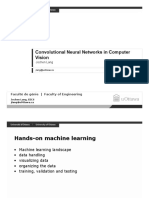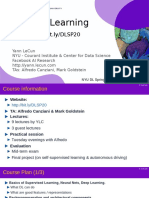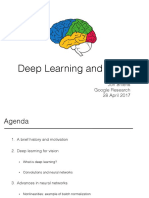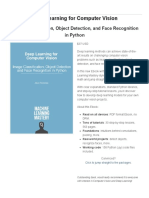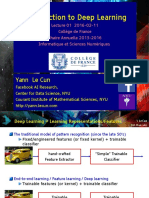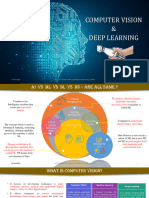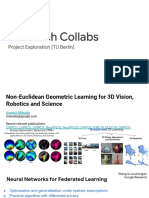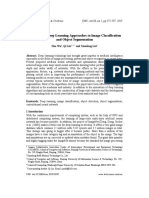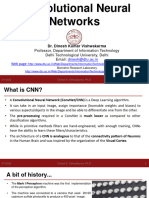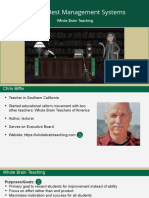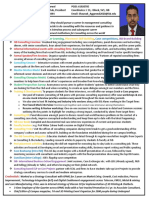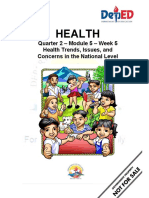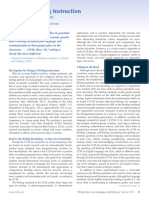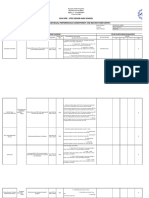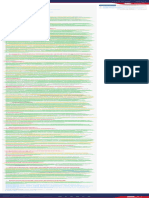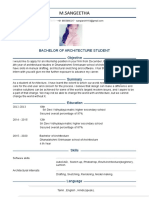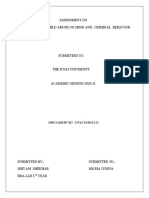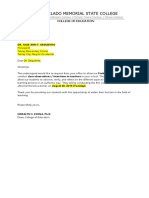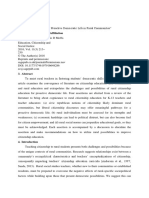498 FA2019 Lecture01
Uploaded by
S Mahapatra498 FA2019 Lecture01
Uploaded by
S MahapatraEECS 498-007 / 598-005
Deep Learning for Computer Vision
Lecture 1: Introduction
Justin Johnson Lecture 1 - 1 September 4, 2019
Deep Learning for Computer Vision
Justin Johnson Lecture 1 - 2 September 4, 2019
Deep Learning for Computer Vision
Building artificial systems
that process, perceive, and
reason about visual data
Justin Johnson Lecture 1 - 3 September 4, 2019
Computer Vision is everywhere!
Left to right:
Image by Roger H Goun is licensed
under CC BY 2.0
Image is CC0 1.0 public domain
Image is CC0 1.0 public domain
Image is CC0 1.0 public domain
Left to right:
Image is free to use
Image is CC0 1.0 public domain
Image by NASA is licensed
under CC BY 2.0
Image is CC0 1.0 public domain
Bottom row, left to right
Image is CC0 1.0 public domain
Image by Derek Keats is
licensed under CC BY 2.0;
changes made
Image is public domain
Image is licensed under CC-BY
2.0; changes made
Justin Johnson Lecture 1 - 4 September 4, 2019
Deep Learning for Computer Vision
Building artificial systems that
learn from data and experience
Justin Johnson Lecture 1 - 5 September 4, 2019
Deep Learning for Computer Vision
Hierarchical learning algorithms
with many “layers”, (very) loosely
inspired by the brain
Justin Johnson Lecture 1 - 6 September 4, 2019
Artificial Intelligence
Justin Johnson Lecture 1 - 7 September 4, 2019
Artificial Intelligence
Machine Learning
Computer
Vision
Justin Johnson Lecture 1 - 8 September 4, 2019
Artificial Intelligence
Machine Learning
Computer Deep
Vision Learning
Justin Johnson Lecture 1 - 9 September 4, 2019
This class
Artificial Intelligence
Machine Learning
Computer Deep
Vision Learning
Justin Johnson Lecture 1 - 10 September 4, 2019
This class
Artificial Intelligence
Machine Learning
Computer Deep
Vision Learning
gu age
l L an
ra
Natu cessing
Pro
Justin Johnson Lecture 1 - 11 September 4, 2019
This class
Artificial Intelligence
Machine Learning
Computer Deep
Vision Learning
gu age
l L an e e ch
ra Sp ition
Natu cessing g n
Pro Re co
Justin Johnson Lecture 1 - 12 September 4, 2019
This class
Artificial Intelligence
Rob
oti cs Machine Learning
Computer Deep
Vision Learning
gu age
l L an e e ch
ra Sp ition
Natu cessing g n
Pro Re co
Justin Johnson Lecture 1 - 13 September 4, 2019
Today’s Agenda
• A brief history of computer vision and deep learning
• Course overview and logistics
Justin Johnson Lecture 1 - 14 September 4, 2019
Hubel and Wiesel, 1959
Measure
brain activity
Simple cells:
Response to light
orientation
Complex cells:
Response to light
orientation and movement
Hypercomplex cells:
response to movement
Cat image by CNX OpenStax is licensed with an end point
under CC BY 4.0; changes made
1959
Hubel & Wiesel
Response Stimulus
No response
Justin Johnson Lecture 1 - 15 September 4, 2019
Larry Roberts, 1963
(a) Original picture (b) Differentiated picture (c) Feature points selected
1959 1963
Hubel & Wiesel Roberts
Justin Johnson Lecture 1 - 16 September 4, 2019
1959 1963
Hubel & Wiesel Roberts
Justin Johnson Lecture 1 - 17 September 4, 2019
2 ½-D sketch 3-D model
Input image Edge image
This image is CC0 1.0 public domain This image is CC0 1.0 public domain
Input Primal 2 ½-D 3-D Model
Image Sketch Sketch Representation
Zero crossings, Local surface 3-D models
blobs, edges, orientation and hierarchically
Perceived bars, ends, discontinuities in organized in
intensities virtual lines, depth and in terms of surface
groups, curves surface and volumetric
boundaries orientation primitives
1959 1963 1970s
Hubel & Wiesel Roberts David Marr
Stages of Visual Representation, David Marr, 1970s
Justin Johnson Lecture 1 - 18 September 4, 2019
Recognition via Parts (1970s)
Generalized Cylinders, Pictorial Structures,
Brooks and Binford, 1979 Fischler and Elshlager, 1973
1959 1963 1970s 1979
Hubel & Wiesel Roberts David Marr Gen. Cylinders
Justin Johnson Lecture 1 - 19 September 4, 2019
Recognition via Edge Detection (1980s)
1959 1963 1970s 1979 1986 John Canny, 1986
Hubel & Wiesel Roberts David Marr Gen. Cylinders Canny David Lowe, 1987
Image is CC0 1.0 public domain
Justin Johnson Lecture 1 - 20 September 4, 2019
Recognition via Grouping (1990s)
1959 1963 1970s 1979 1986 1997
Hubel & Wiesel Roberts David Marr Gen. Cylinders Canny Norm. Cuts
Normalized Cuts, Shi and Malik, 1997
AI Winter
Left Image is CC BY 3.0 Middl Image is public domain Right Image is CC-BY 2.0; changes made
Justin Johnson Lecture 1 - 21 September 4, 2019
Recognition via Matching (2000s)
Image is public domain
Image is public domain
1959 1963 1970s 1979 1986 1997 1999 SIFT, David
Hubel & Wiesel Roberts David Marr Gen. Cylinders Canny Norm. Cuts SIFT
Lowe, 1999
AI Winter
Justin Johnson Lecture 1 - 22 September 4, 2019
Face Detection
Viola and Jones, 2001
One of the first successful
applications of machine
learning to vision
1959 1963 1970s 1979 1986 1997 1999 2001
Hubel & Wiesel Roberts David Marr Gen. Cylinders Canny Norm. Cuts SIFT V&J
AI Winter
Justin Johnson Lecture 1 - 23 September 4, 2019
PASCAL Visual Object Challenge
Image is CC0 1.0 public domain
Train
Person
Airplane
Image is CC0 1.0 public domain
1959 1963 1970s 1979 1986 1997 1999 2001 2001
Hubel & Wiesel Roberts David Marr Gen. Cylinders Canny Norm. Cuts SIFT V&J PASCAL
AI Winter
Justin Johnson Lecture 1 - 24 September 4, 2019
Output:
The Image Classification Challenge: Scale
T-shirt
1,000 object classes Steel drum
1,431,167 images Drumstick
Mud turtle
Deng et al, 2009
Russakovsky et al. IJCV 2015
1959 1963 1970s 1979 1986 1997 1999 2001 2001 2009
Hubel & Wiesel Roberts David Marr Gen. Cylinders Canny Norm. Cuts SIFT V&J PASCAL ImageNet
AI Winter
Justin Johnson Lecture 1 - 25 September 4, 2019
Enter Deep Learning
1959 1963 1970s 1979 1986 1997 1999 2001 2001 2009
Hubel & Wiesel Roberts David Marr Gen. Cylinders Canny Norm. Cuts SIFT V&J PASCAL ImageNet
AI Winter
2012
AlexNet
Justin Johnson Lecture 1 - 26 September 4, 2019
AlexNet: Deep Learning Goes Mainstream
Krizhevsky, Sutskever, and Hinton, NeurIPS 2012
1959 1963 1970s 1979 1986 1997 1999 2001 2001 2009
Hubel & Wiesel Roberts David Marr Gen. Cylinders Canny Norm. Cuts SIFT V&J PASCAL ImageNet
AI Winter
2012
AlexNet
Justin Johnson Lecture 1 - 27 September 4, 2019
Perceptron
One of the earliest algorithms that could learn from data
Implemented in hardware! Weights stored in potentiometers,
updated with electric motors during learning
Connected to a camera that used 20x20 cadmium sulfide
photocells to make a 400-pixel image
Could learn to recognize letters of the alphabet
Today we would recognize it as a linear classifier
Frank Rosenblatt, ~1957
1959 1963 1970s 1979 1986 1997 1999 2001 2001 2009
Hubel & Wiesel Roberts David Marr Gen. Cylinders Canny Norm. Cuts SIFT V&J PASCAL ImageNet
AI Winter
1958 2012
Perceptron AlexNet
Justin Johnson Lecture 1 - 28 September 4, 2019
Minsky and Papert, 1969
X Y F(x,y) y
0 0 0
0 1 1
1 0 1
1 1 0 x
Showed that Perceptrons could not learn the XOR function
Caused a lot of disillusionment in the field
1959 1963 1970s 1979 1986 1997 1999 2001 2001 2009
Hubel & Wiesel Roberts David Marr Gen. Cylinders Canny Norm. Cuts SIFT V&J PASCAL ImageNet
AI Winter
1958 1969 2012
Perceptron Minsky & Papert AlexNet
Justin Johnson Lecture 1 - 29 September 4, 2019
Neocognitron: Fukushima, 1980
Computational model the visual system,
directly inspired by Hubel and Wiesel’s
hierarchy of complex and simple cells
Interleaved simple cells (convolution)
and complex cells (pooling)
No practical training algorithm
1959 1963 1970s 1979 1986 1997 1999 2001 2001 2009
Hubel & Wiesel Roberts David Marr Gen. Cylinders Canny Norm. Cuts SIFT V&J PASCAL ImageNet
AI Winter
1958 1969 1980 2012
Perceptron Minsky & Papert Neocognitron AlexNet
Justin Johnson Lecture 1 - 30 September 4, 2019
Neocognitron: Fukushima, 1980
Looks a lot like AlexNet
more than 32 years later!
1959 1963 1970s 1979 1986 1997 1999 2001 2001 2009
Hubel & Wiesel Roberts David Marr Gen. Cylinders Canny Norm. Cuts SIFT V&J PASCAL ImageNet
AI Winter
1958 1969 1980 2012
Perceptron Minsky & Papert Neocognitron AlexNet
Justin Johnson Lecture 1 - 31 September 4, 2019
Backprop: Rumelhart, Hinton, and Williams, 1986
Introduced backpropagation
for computing gradients in
neural networks recognizable
math
Successfully trained
perceptrons with multiple
layers
Illustration of Rumelhart et al., 1986 by Lane McIntosh,
copyright CS231n 2017
1959 1963 1970s 1979 1986 1997 1999 2001 2001 2009
Hubel & Wiesel Roberts David Marr Gen. Cylinders Canny Norm. Cuts SIFT V&J PASCAL ImageNet
AI Winter
1958 1969 1980 1985 2012
Perceptron Minsky & Papert Neocognitron Backprop AlexNet
Justin Johnson Lecture 1 - 32 September 4, 2019
Convolutional Networks: LeCun et al, 1998
Applied backprop algorithm to a Neocognitron-like architecture
Learned to recognize handwritten digits
Was deployed in a commercial system by NEC, processed handwritten checks
Very similar to our modern convolutional networks!
1959 1963 1970s 1979 1986 1997 1999 2001 2001 2009
Hubel & Wiesel Roberts David Marr Gen. Cylinders Canny Norm. Cuts SIFT V&J PASCAL ImageNet
AI Winter
1958 1969 1980 1985 1998 2012
Perceptron Minsky & Papert Neocognitron Backprop LeNet AlexNet
Justin Johnson Lecture 1 - 33 September 4, 2019
2000s: “Deep Learning”
People tried to train neural networks that
were deeper and deeper
Not a mainstream research topic at this time
Hinton and Salakhutdinov, 2006
Bengio et al, 2007
Lee et al, 2009
Glorot and Bengio, 2010
1959 1963 1970s 1979 1986 1997 1999 2001 2001 2009
Hubel & Wiesel Roberts David Marr Gen. Cylinders Canny Norm. Cuts SIFT V&J PASCAL ImageNet
AI Winter
1958 1969 1980 1985 1998 2006 2012
Perceptron Minsky & Papert Neocognitron Backprop LeNet Deep Learning AlexNet
Justin Johnson Lecture 1 - 34 September 4, 2019
2012 to Present: Deep Learning Explosion
Google Trends: “Deep Learning” Publications at top Computer Vision conference
1959 1963 1970s 1979 1986 1997 1999 2001 2001 2009
Hubel & Wiesel Roberts David Marr Gen. Cylinders Canny Norm. Cuts SIFT V&J PASCAL ImageNet
AI Winter
1958 1969 1980 1985 1998 2006 2012
Perceptron Minsky & Papert Neocognitron Backprop LeNet Deep Learning AlexNet
Justin Johnson Lecture 1 - 35 September 4, 2019
2012 to Present: ConvNets are everywhere
Image Classification Image Retrieval
Figures copyright Alex Krizhevsky, Ilya Sutskever, and Geoffrey Hinton, 2012. Reproduced with permission.
Justin Johnson Lecture 1 - 36 September 4, 2019
2012 to Present: ConvNets are everywhere
Object Detection Image Segmentation
Ren, He, Girshick, and Sun, 2015 Fabaret et al, 2012
Justin Johnson Lecture 1 - 37 September 4, 2019
2012 to Present: ConvNets are everywhere
Video Classification Activity Recognition
Simonyan et al, 2014
Justin Johnson Lecture 1 - 38 September 4, 2019
2012 to Present: ConvNets are everywhere
Pose Recognition (Toshev and Szegedy, 2014)
Playing Atari games (Guo et al, 2014)
Justin Johnson Lecture 1 - 39 September 4, 2019
2012 to Present: ConvNets are everywhere
Medical Imaging
Whale recognition
Levy et al, 2016 Figure reproduced with permission
Galaxy Classification
Dieleman et al, 2014
From left to right: public domain by NASA, usage permitted by
ESA/Hubble, public domain by NASA, and public domain. Kaggle Challenge This image by Christin Khan is in the public domain and
originally came from the U.S. NOAA.
Justin Johnson Lecture 1 - 40 September 4, 2019
2012 to Present: ConvNets are everywhere
A white teddy bear A man in a baseball A woman is holding
Image Captioning sitting in the grass uniform throwing a ball a cat in her hand
Vinyals et al, 2015
Karpathy and Fei-Fei, 2015
All images are CC0 Public domain:
https://pixabay.com/en/luggage-antique-cat-1643010/
https://pixabay.com/en/teddy-plush-bears-cute-teddy-bear-1623436/
https://pixabay.com/en/surf-wave-summer-sport-litoral-1668716/ A man riding a wave A cat sitting on a A woman standing on a
on top of a surfboard
https://pixabay.com/en/woman-female-model-portrait-adult-983967/
https://pixabay.com/en/handstand-lake-meditation-496008/
https://pixabay.com/en/baseball-player-shortstop-infield-1045263/
suitcase on the floor beach holding a surfboard
Captions generated by Justin Johnson using Neuraltalk2
Justin Johnson Lecture 1 - 41 September 4, 2019
Original image is CC0 public domain
Starry Night and Tree Roots by Van Gogh are in the public domain
Bokeh image is in the public domain Mordvinsev et al, 2015
Stylized images copyright Justin Johnson, 2017;
reproduced with permission
Gatys et al, 2016
Figures copyright Justin Johnson, 2015. Reproduced with permission. Generated using the Inceptionism approach from a blog post by Google Research.
Justin Johnson Lecture 1 - 42 September 4, 2019
Algorithms
Data
Computation
Justin Johnson Lecture 1 - 43 September 4, 2019
18
GigaFLOPs per Dollar
CPU GPU Deep Learning Explosion
16
14
12
GTX 1080 Ti
10
8
GeForce
6
GTX 580
(AlexNet)
4
GeForce
2
8800 GTX
0
1/2004 10/2006 7/2009 4/2012 12/2014 9/2017
Time
Justin Johnson Lecture 1 - 44 September 4, 2019
2018 Turing Award
Yoshua Bengio Geoffrey Hinton Yann LeCun
1959 1963 1970s 1979 1986 1997 1999 2001 2001 2009
Hubel & Wiesel Roberts David Marr Gen. Cylinders Canny Norm. Cuts SIFT V&J PASCAL ImageNet
AI Winter
1958 1969 1980 1985 1998 2006 2012 2018
Perceptron Minsky & Papert Neocognitron Backprop LeNet Deep Learning AlexNet Turing Award
Justin Johnson Lecture 1 - 45 September 4, 2019
Despite our success, computer
vision still has a long way to go…
Justin Johnson Lecture 1 - 46 September 4, 2019
This image is copyright- Example credit:
free United States
government work Andrej Karpathy
Justin Johnson Lecture 1 - 47 September 4, 2019
Computer Vision Technology
Can Better Our Lives
Outside border images, clockwise, starting from top left:
Image by Pop Culture Geek is licensed under CC BY 2.0; changes made
Image by the US Government is in the public domain Inside four images, clockwise, starting from top left:
Image by the US Government is in the public domain Image is CC0 1.0 public domain
Image by Glogger is licensed under CC BY-SA 3.0; changes made Image by Tucania is licensed under CC BY-SA 3.0; changes made
Image by Sylenius is licensed under CC BY 3.0; changes made Image by Intuitive Surgical, Inc. is licensed under CC BY-SA 3.0; changes made
Image by US Government is in the public domain Image by Oyundari Zorigtbaatar is licensed under CC BY-SA 4.0
Justin Johnson Lecture 1 - 48 September 4, 2019
Today’s Agenda
• A brief history of computer vision and deep learning
• Course overview and logistics
1959 1963 1970s 1979 1986 1997 1999 2001 2001 2009
Hubel & Wiesel Roberts David Marr Gen. Cylinders Canny Norm. Cuts SIFT V&J PASCAL ImageNet
AI Winter
1958 1969 1980 1985 1998 2006 2012 2018
Perceptron Minsky & Papert Neocognitron Backprop LeNet Deep Learning AlexNet Turing Award
Justin Johnson Lecture 1 - 49 September 4, 2019
Today’s Agenda
• A brief history of computer vision and deep learning
• Course overview and logistics
1959 1963 1970s 1979 1986 1997 1999 2001 2001 2009 2019
Hubel & Wiesel Roberts David Marr Gen. Cylinders Canny Norm. Cuts SIFT V&J PASCAL ImageNet This class
AI Winter
1958 1969 1980 1985 1998 2006 2012 2018
Perceptron Minsky & Papert Neocognitron Backprop LeNet Deep Learning AlexNet Turing Award
Justin Johnson Lecture 1 - 50 September 4, 2019
Course Staff
Instructor Graduate Student Instructors
Justin Johnson Yunseok Jang Kibok Lee Luowei Zhao
Assistant Professor, CSE PhD student, CSE PhD student, CSE PhD student, RI
Video understanding, Robustness, Vision & Language
Generative models Generalization
Justin Johnson Lecture 1 - 51 September 4, 2019
How to contact us
• Course Website: https://web.eecs.umich.edu/~justincj/teaching/eecs498/
• Syllabus, schedule, assignments, slides, lecture videos, etc
• Piazza: https://piazza.com/class/k01uvwqmf8c4nb
• (Almost) all questions about the course should go here!
• We will also use Piazza to communicate with you
• Use private questions if you want to post code
• Canvas:
• For turning in homework assignments
• Google Calendar: For office hours (starting next week)
• Email: Only for sensitive, confidential issues
Justin Johnson Lecture 1 - 52 September 4, 2019
Optional Textbook
• Deep Learning by Goodfellow,
Bengio, and Courville
• Free online
Justin Johnson Lecture 1 - 53 September 4, 2019
Course Content and Grading
• 6 programming assignments (10% each)
• Homework assignments will use Python, PyTorch, and Google Colab
• Midterm Exam (20%)
• Final Exam (20%)
• Late policy
• 3 free late days to use on assignments
• Once free late days are exhausted, 25% penalty per day
Justin Johnson Lecture 1 - 54 September 4, 2019
Course Content and Grading
• 6 programming assignments (10% each)
• Homework assignments will use Python, PyTorch, and Google Colab
• Midterm Exam (20%)
• Final Exam (20%)
• Late policy
• 3 free late days to use on assignments
• Once free late days are exhausted, 25% penalty per day
Justin Johnson Lecture 1 - 55 September 4, 2019
Collaboration Policy
• Rule 1: Don’t look at solutions or code that are not your
own; everything you submit should be your own work
• Rule 2: Don’t share your solution code with others; however
discussing ideas or general strategies is fine and encouraged
• Rule 3: Indicate in your submissions anyone you worked with
• Turning in something late / incomplete is better than
violating the honor code
Justin Johnson Lecture 1 - 56 September 4, 2019
Course Philosophy
• Thorough and Detailed.
• This not “Learn PyTorch in 90 days”, nor “Deep Learning in 10 lines of code”
• Understand how to write from scratch, debug, and train convolutional and
other types of deep neural networks
• We prefer to write from scratch, rather than rely on existing implementations
• Practical
• Focus on practical techniques for training and debugging neural networks
• Will use state-of-the-art software tools like PyTorch and TensorFlow
• State of the art
• Most material we cover is research published in the last 5 years
Justin Johnson Lecture 1 - 57 September 4, 2019
Course Philosophy
• Will also cover some fun topics:
• Image captioning (with RNNs)
• DeepDream, Artistic Style Transfer
Justin Johnson Lecture 1 - 58 September 4, 2019
Course Structure
• First half: Fundamentals
• Details of how to implement and train different types of networks
• Fully-connected networks, convolutional networks, recurrent networks
• How to train and debug, very detailed
• Second half: Applications and “Researchy” topics
• Object detection, image segmentation, 3D vision, videos
• Attention, Transformers
• Vision and Language
• Generative models: GANs, VAEs, etc
• Less detailed: provide overview and references, but skip some details
Justin Johnson Lecture 1 - 59 September 4, 2019
First homework assignment
• Will be released over the weekend
• Due one week after release
• Monday’s lecture will be enough to complete it
Justin Johnson Lecture 1 - 60 September 4, 2019
Next time: Image Classification
Justin Johnson Lecture 1 - 61 September 4, 2019
You might also like
- CS231n Intro: CNNs for Visual RecognitionNo ratings yetCS231n Intro: CNNs for Visual Recognition52 pages
- Lecture 1 - : Fei-Fei Li & Justin Johnson & Serena YeungNo ratings yetLecture 1 - : Fei-Fei Li & Justin Johnson & Serena Yeung53 pages
- Sloman-Beyond-Gibson - David Marr - GIbsonNo ratings yetSloman-Beyond-Gibson - David Marr - GIbson39 pages
- TensorFlow Meetup: Deep Learning InsightsNo ratings yetTensorFlow Meetup: Deep Learning Insights19 pages
- Computational Intelligence and Neuroscience - 2018 - Voulodimos - Deep Learning For Computer Vision A Brief ReviewNo ratings yetComputational Intelligence and Neuroscience - 2018 - Voulodimos - Deep Learning For Computer Vision A Brief Review13 pages
- Lecture 1 - : Fei-Fei Li & Andrej Karpathy & Justin JohnsonNo ratings yetLecture 1 - : Fei-Fei Li & Andrej Karpathy & Justin Johnson47 pages
- Prerequisites: What Is Computer Vision? Vision For MeasurementNo ratings yetPrerequisites: What Is Computer Vision? Vision For Measurement8 pages
- Slides 11 - Image Pattern ClassificationNo ratings yetSlides 11 - Image Pattern Classification86 pages
- Vbook - Pub Deep Learning For Computer VisionpdfNo ratings yetVbook - Pub Deep Learning For Computer Visionpdf24 pages
- Computer Vision and Deep Learning 1708702317No ratings yetComputer Vision and Deep Learning 170870231793 pages
- Unit 2 - Neural Networks (DL Illustrated)No ratings yetUnit 2 - Neural Networks (DL Illustrated)146 pages
- A Review On Deep Learning Approaches To Image Classification and Object Segmentation 1No ratings yetA Review On Deep Learning Approaches To Image Classification and Object Segmentation 123 pages
- 2019 Book ComputerVisionACCV2018WorkshopNo ratings yet2019 Book ComputerVisionACCV2018Workshop549 pages
- Semantic Image Segmentation for Autonomous DrivingNo ratings yetSemantic Image Segmentation for Autonomous Driving38 pages
- Bmva Ss 2018 Breckon Deepmachinelearning PDFNo ratings yetBmva Ss 2018 Breckon Deepmachinelearning PDF120 pages
- (Group 16) Analysis of English Language Needs For Military PersonnelNo ratings yet(Group 16) Analysis of English Language Needs For Military Personnel15 pages
- ISB Consulting Club Overview & InitiativesNo ratings yetISB Consulting Club Overview & Initiatives1 page
- G10 Q2 Health Module 5 - For Reg - L EditingNo ratings yetG10 Q2 Health Module 5 - For Reg - L Editing8 pages
- San Jose - Litex Senior High School Part 1: Individual Performance Commitment and Review Form (Ipcrf)No ratings yetSan Jose - Litex Senior High School Part 1: Individual Performance Commitment and Review Form (Ipcrf)12 pages
- 3113 Analytics Decision Making June 2023No ratings yet3113 Analytics Decision Making June 20232 pages










